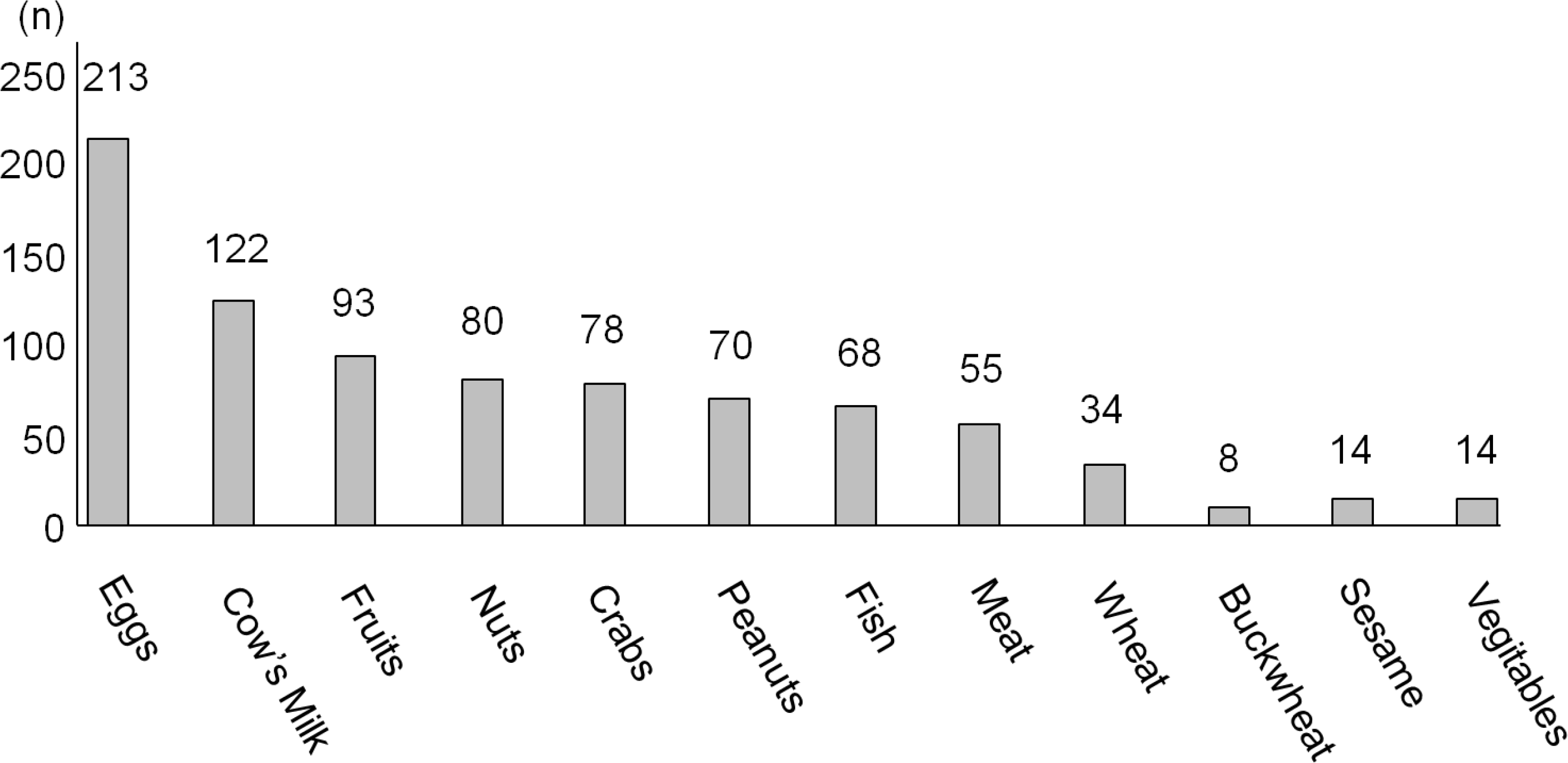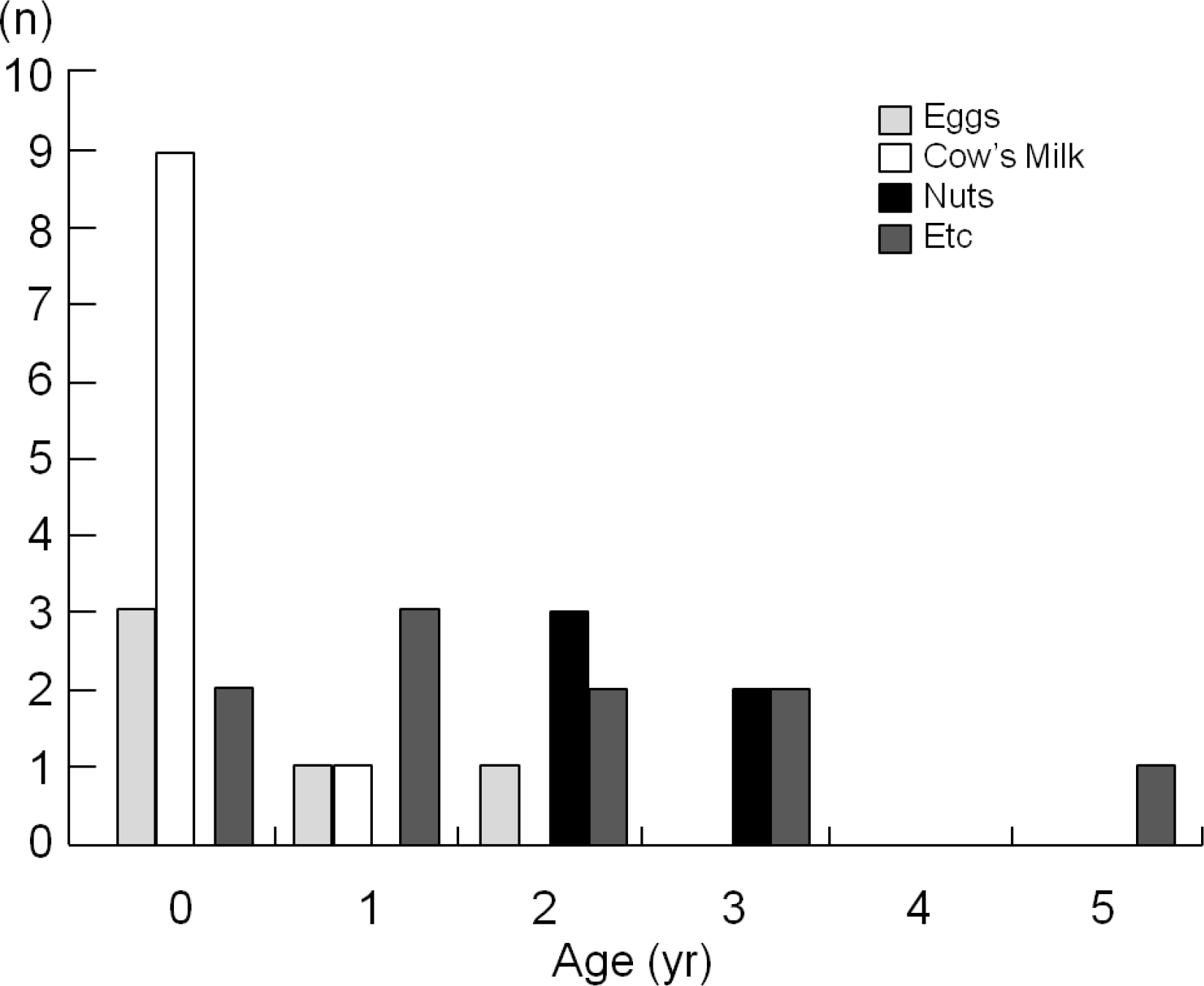Abstract
Methods
1) The survey was conducted in April 2010 in Seoul, Korea. Three hundred forty-five child care centers caring for children between the ages of 0 and 5 years were contacted by mail. The questionnaire was designed to identify symptoms and management of children in child care centers with histories of food allergies. 2) We studied children who were diagnosed with angioedema or anaphylaxis between January 2002 and August 2010 in the ED of Korea University.
Results
1) According to the 345 collected questionnaires, 243 child care centers asked parents about their children's allergic diseases and 492 children had food allergies. A reported 461 children from 207 child care centers had food restrictions. Only 21 child care centers supplied substitute foods with the same amounts and types of nutrients. One hundred forty-five teachers had received education about food allergies. 2) Thirty children were diagnosed with anaphylaxis or angioedema after food ingestion. Only seven children visited a physician after being discharged from the ED.
Go to : 
References
2. Sampson HA. Adverse reactions to foods. In: Adkinson JNF, BS B, JW Y, ST H, WW B, FER S, editors. Middleton's allergy: principle and practice 6th ed. St. Louise Mosby. 2003. 1619–43.
4. Rona RJ, Keil T, Summers C, Gislason D, Zuidmeer L, Sodergren E, et al. The prevalence of food allergy: a metaanalysis. J Allergy Clin Immunol. 2007; 120:638–46.

5. The Korean Academy of Pediatric Allergy and Respiratory disease Committee on Epidemiology. The epidemiologic survey of allergic disease in Korean children-adolescent: Atopic dermatitis and food allergy. 2002; Suppl 1:57–60.
6. Simons FER. Anaphylaxis: Recent advances in assessment and treatment. J Allergy Clin Immunol. 2009; 124:625–36.

9. Imamura T, Kanagawa Y, Ebisawa M. A survey of patients with self-reported severe food allergies in Japan. Pediatr Allergy Immunol. 2008; 19:270–4.

10. Food Allergy & Anaphylaxis Alliance. Available from:. http://www.foodallergyalliance.org/.
11. Sampson HA, Muñoz-Furlong A, Campbell RL, Adkinson JNF, Allan Bock S, Branum A, et al. Second Symposium on the Definition and Management of Anaphylaxis: Summary Report –Second National Institute of Allergy and Infectious Disease/Food Allergy and Anaphylaxis Network Symposium. Ann Emerg Med. 2006; 47:373–80.
12. Mehl A, Wahn U, Niggemann B. Anaphylactic reactions in children-a questionnaire-based survey in Germany. Allergy. 2005; 60:1440–5.
13. Roh EJ, Chung EH, Lee MH, Lee SJ, Youn YS, Lee JH, et al. Clinical Features of Anaphylaxis in the Middle Area of South Korea. Pediatr Allergy Respir Dis(Korea). 2008; 18:61–9.
14. Zuidmeer L, Goldhahn K, Rona RJ, Gislason D, Madsen C, Summers C, et al. The prevalence of plant food allergies: a systematic review. J Allergy Clin Immunol. 2008; 121:1210–8.

16. Wuthrich B. Lethal or life-threatening allergic reactions to food. J Investig Allergol Clin Immunol. 2000; 10:59–65.
17. Young MC, Munoz-Furlong A, Sicherer SH. Management of food allergies in schools: a perspective for allergists. J Allergy Clin Immunol. 2009; 124:175–82.

18. Fatal anaphylactic reactions to food in children. Allergy Section, Canadian Paediatric Society. CMAJ. 1994; 150:337–9.
19. Sampson HA, Mendelson L, Rosen JP. Fatal and near-fatal anaphylactic reactions to food in children and adolescents. N Engl J Med. 1992; 327:380–4.

20. Munoz-Furlong A. Food allergy in schools: concerns for allergists, pediatricians, parents, and school staff. Ann Allergy Asthma Immunol. 2004; 93(5 suppl 3):47S–50S.
Go to : 
 | Fig. 1.Parentally reported food allergens in the 492 children with food allergies at the 345 participating child care centers. |
 | Fig. 2.Allergen related to angioedema and anaphylaxis in 30 children who visited emergency department in hospitals of Korea University from Jan 2000 to Aug 2008. |
Table 1.
Allergic Diseases of Children Enrolled at Participating 345 Child Care Centers Reported by Parents
| Age (yr) | Numbers | Food allergy | Atopic dermatitis | Other allergic disease∗ |
|---|---|---|---|---|
| 0 | 724 | 13 (1.8%) | 66 (9.2%) | 15 (2.1%) |
| 1 | 3,159 | 84 (2.6%) | 286 (9.1%) | 18 (0.6%) |
| 2 | 5,572 | 119 (2.1%) | 411 (7.4%) | 64 (1.1%) |
| 3 | 6,580 | 117 (1.8%) | 399 (6.1%) | 80 (1.2%) |
| 4 | 6,344 | 93 (1.5%) | 393 (6.2%) | 90 (1.4%) |
| 5 | 6,039 | 78 (1.3%) | 341 (5.6%) | 80 (1.3%) |
| Total | 28,027 | 492 (1.7%) | 1,753 (6.3%) | 347 (1.2%) |




 PDF
PDF ePub
ePub Citation
Citation Print
Print


 XML Download
XML Download